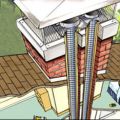CHIMNEY CLEANING SERVICE
In the era between 1600 and 1800, heating was done using fireplaces alone. These deposited soot and creosote on unlined chimneys and it was necessary to hire a chimney sweep to clean out the residue. In addition to brushes, small children were often placed inside the chimneys. The resulting inhalation of soot caused much sickness and death. It has been said that even tethered geese were used to beat the soot off the sides of a chimney.
Being a chimney sweep in this era was among the lowest positions one could help—yet the service was absolutely necessary. To raise their perceived status, sweeps would obtain leftover men’s fashions—top hats and tails were the clothes men wore—from undertakers. You might get an idea of what they looked like if you can remember Dick Van Dyke in Mary Poppins.
Today, fewer chimney sweeps still don the hat and tails, but the concern for soot and creosote remains the same. The modern day chimney sweep has at his disposal high-powered vacuums and a selection of tools and chemicals that ease the work.
The Necessary Knowledge
Today’s chimney cleaning service must know the following to do the job properly:
· National Fire Protection Association Standard 211 becomes the basis for inspecting the chimney, which is the first task to be done.
· Local residential codes covering the construction, maintenance, and modification of the chimney system in a home.
· The diagnosis of performance problems, such as draft, airflow, changes in flow direction, measuring inadequate flow, and the handling of pressure and updrafts.
· A knowledge of the equipment being used to remove soot and creosote from the chimney. This requires knowing what brushes to use to fit the flues, what shape and texture of brushes to use.
· The methods of sweeping chimneys (bottom to top; top to bottom), fireboxes, smoke chambers, dampers, and flues for an assortment of appliances, including masonry and prefabricated fireplaces, wood stoves and furnaces, using both wire and polyvinylchloride brushes, as appropriate to the surface being cleaned.
· Perform parging and repair services to smoke chambers and damper areas, as required, including the addition of high temperature mortar on the inside of the chimney where necessary. To parge is to cover an external brick wall with plaster or mortar.
· Take steps to protect the site from dust and soot, using tarps, runners, and drop cloths, as necessary.
· The physical requirements:
· The ability to position and climb ladders and roofs, as appropriate.
· The ability to stand, squat, and sit inside a fireplace to access smoke chamber interiors.
· The ability to stand on scaffolding and ladders with no concern for vertigo.
· The ability to work over the head, with some lifting.
The Job Requirements
These tasks are also included:
· Communicate with the customer. Telling the customer the true condition of the chimney, the requirements of the NFPA, and the repairs required. Document those communications using appropriate reports.
· Install chimney covers.
· Do minor repairs to firebox and chimney crowns.
· Maintain the cleaning equipment—tools, vacuums, rolling stock.
· Acquire Red Cross First Aid and CPR training as mandated by the chimney cleaning service firm.
Available Education
Chimney sweeping is an apprenticeship trade. As such, it has a trade association, the Chimney Safety Institute of America, located in Indianapolis, Indiana. That organization has a technology center where they offer the National Chimney Sweep Training School. The school provides classroom training, hands-on experience, and all the terminology, theory, tools, systems, and processes required to perform the tasks.
This is not an idle activity. Chimney sweeps have ongoing education and certification requirements. Because there is always the possibility of injury, chimney sweeps also undergo safety training.
Source: Click Here




